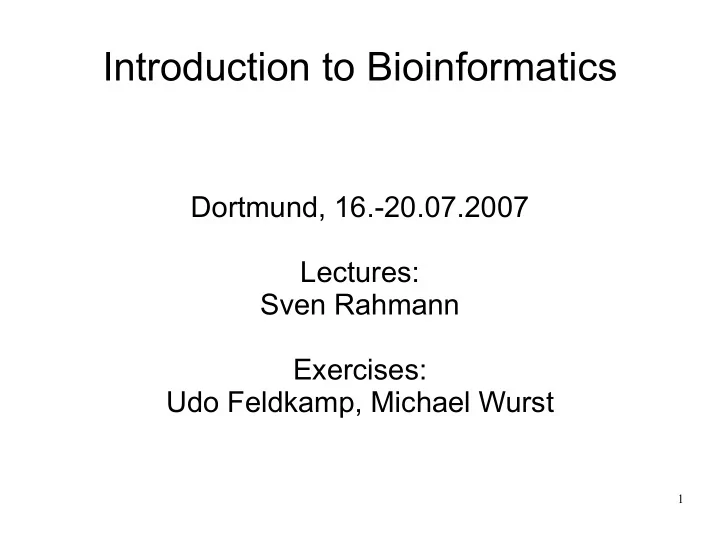

Introduction to Bioinformatics Dortmund, 16.-20.07.2007 Lectures: Sven Rahmann Exercises: Udo Feldkamp, Michael Wurst 1
Goals of this course ● Learn about – Software tools – Databases – Methods (Algorithms) in bioinformatics ● Know what's out there (too much!) ● Acquire first experience with a selection of standard tools 2
Overview ● Monday: lectures and exercises – What is bioinformatics? – Literature databases – Bioinformatics databases – Sequence analysis ● pairwise sequence alignment (theory) 3
Overview ● Tuesday: all-lecture day – Sequence Analysis (cont'd) ● sequence database search (BLAST, BLAT) ● multiple sequence alignment (CLUSTAL) ● protein domain analysis (HMMs) – Phylogenetics – Protein structure – Transcriptomics: Gene expression analysis 4
Overview ● Wednesday: all-exercise day 5
Overview ● Thursday: lectures and exercises – Networks – Systems biology 6
Overview ● Friday: exam day – oral exams in small groups – questions – practical exercises at the computer 7
What is Bioinformatics ? 8
What is Bioinformatics? ● Biology: bio = life, logos = science ● Earlier centuries: cataloging life forms ● Today: molecular biology (discovery of DNA) ● Basis of modern molecular biology: chemistry ● Life = islands of order or information in chaos ● Information = deviation from randomness ● Informatics: information processing ● Bio-informatics: natural combination 9
Bio-? ● Biology ● Bio-? := – Science ? helps to understand biology – Biology inspires new research directions in ? ● Biochemistry ● Biophysics ● Biotechnology ● Biomathematics ● Bioinformatics 10
Bioinformatics – a wide field ● Biomathematics Theoretical ● Theoretical biology ● Ecology ● Biostatistics ● Sequence analysis ● Computational biology ● Bioinformatics ● Systems biology ● Computational *-omics – genomics, transcriptomics, proteomics, ... 11 Applied ● Applied or practical bioinformatics
Definition (for this course) ● Bioinformatician := person who uses models, methods, programs from computer science and mathematics to solve problems arising in the molecular life sciences ● Bioinformatics user := person who uses bioinformatics software 12
Informatics in Biology ● Management of large amounts of data – Databases, Data warehouses – Laboratory Information Management Systems (LIMS) ● Analysis of large amounts of data – efficient algorithms – fast computers and other hardware ● Experiment design – most new knowledge at lowest cost ● Simulations – avoid expensive lab work altogether 13
Contrast: DNA Computing ● Bioinformatics is not DNA computing. ● DNA computing := Using DNA to solve computational problems ● DNA is an information-storing molecule and can “react” to changes in the environment: It can be used as a computational device. ● Adleman (1994) solved the 7-point Hamiltonian path problem with DNA molecules: "Molecular Computation Of Solutions To Combinatorial Problems". Science 266(11): 1021–1024 14
Know your Bioinformatician ● Theoretician? ● Modeler? ● Software Engineer? ● Programmer? Language? ● Database developer? ● Biologist with computer training? ● Lab experience? ● ... 15
About myself ● Diploma in mathematics (applied probability) (statistics of sequences) ● PhD in bioinformatics (efficient algorithms for oligo microarray design) ● Research group leader computational methods for emerging technologies (in the life sciences) ● Main job: – “Extract” computational essence or model from a real-world problem – Develop methods for solving it – translate back results 16
How I like to work ● Learn about an interesting problem – by chance, or by actively seeking a new one ● Gather information about the problem – talk to people, read review papers, who else? ● Wait for new clever ideas ... ● Try out (and frequently modify) these ideas ● Turn ideas into a software product ● Write the publication 17
Example: Microarray Design ● Microarrays contain 100 000s of DNA probes ● For gene expression analysis, probes must be transcript-specific (otherwise: crosshybridization) ● How to select probes for large arrays efficiently? 18
Example: Microarray Design ● Modeling: How to measure cross-hyb. risk? – binding energy? – percent identity between probe and transcript? – longest common substring (perfect match)? ● Algorithmics: Which of these allows fast algorithms? Which data structures are needes? – Fast LCS computation using enhanced suffix arrays ● Software: – input/output format? – language, operating system? (PERL, Java vs. C) 19
Recommended Reading ● JM Claverie and C Notredame: Bioinformatics for Dummies , 2 nd ed. (2006) Wiley ● DW Mount: Bioinformatics: Sequence and Genome Analysis , 2 nd ed. (2004) Cold Spring Harbor Laboratory Press 20
A Few Web Resources ● A lot of material and software in bioinformatics is freely available on the WWW. ● Good starting points: – NCBI: http://www.ncbi.nlm.nih.gov/ (US National Center for Biotechnology Information) – Journal NAR (Nucleic Acids Research) at http://nar.oxfordjournals.org publishes ● database issue ● web server issue see DB list at http://www3.oup.co.uk/nar/database/c/ – BiBiServ (Bielefeld Bioinformatics Server): http://bibiserv.techfak.uni-bielefeld.de/ 21
Recommend
More recommend